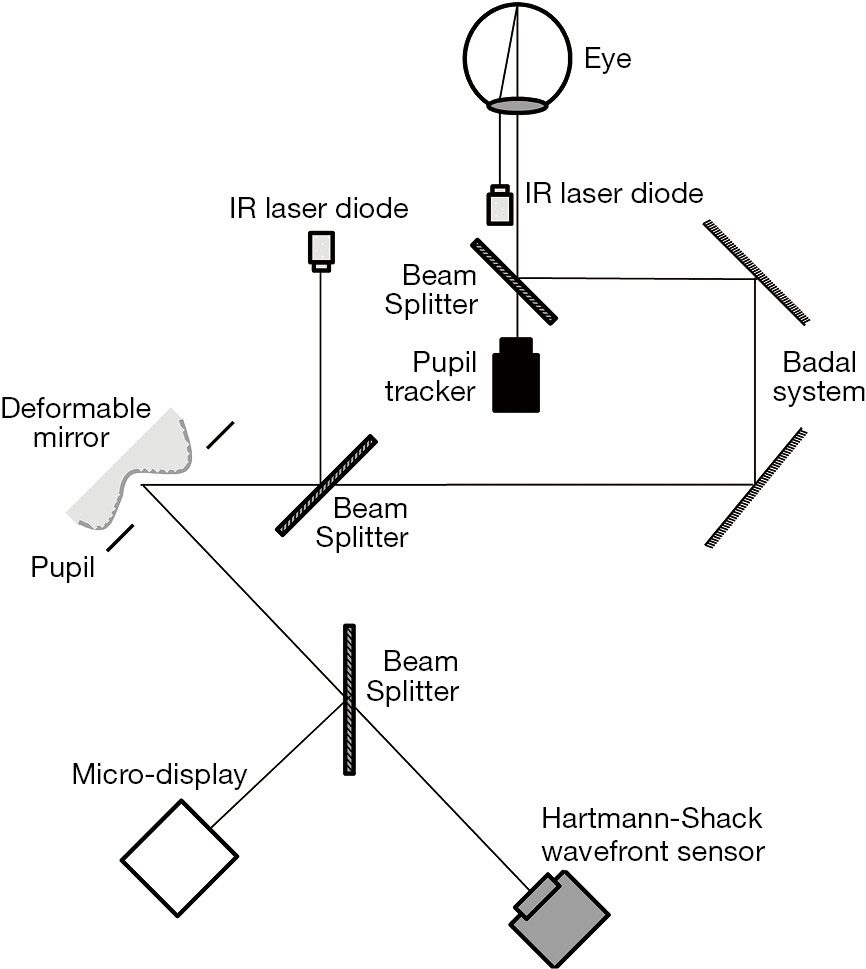The use of adaptive optics systems in ophthalmic research studies has increased in the last years thanks to the development of more accurate devices. Adaptive optics was first introduced in Astronomy for the correction of the effects produced by the turbulences of the Earth’s atmosphere when observing astronomical objects (1,2). Sophisticated deformable mirrors controlled by computers can correct in real time atmospheric disturbances, allowing for much finer details on the images of distance objects. Adaptive optics technology makes it possible to correct many of the aberrations with which the wavefront, i.e., the geometric envelope of all the rays of light that emerged at the same time of the observed object, arrives. Adaptive optics allows for obtaining sharper images, and thus, with better spatial resolution.
In an adaptive optics based system, the optical wavefront, disturbed by the atmosphere, is first analysed by a wavefront sensor to determine its aberrations. This information is taken into account to calculate the deformations that are necessary to be adopted by the deformable mirrors to compensate for the original aberrations of the optical wavefront.
Although this technology has traditionally found its natural field of application in Astronomy, it is currently also being used in systems and methods applied to the study of human vision (3). Thus, examinations made by ophthalmologists to observe the fundus eye are limited by the own aberrations of the human eye (4). Through the use of adaptive optics, it is possible to observe the posterior eye structures with hitherto unusual resolution. Adaptive optics systems have been then successfully applied to correct the optical aberrations of the human eye, to improve vision controlling the type and amount of aberrations to which the retina is exposed, and to control at will the wavefront aberrations presented to the human eye in research studies (5).
One of the adaptive optics system that we have used, whose basic sketch is shown in Figure 1, comprises two basic elements: a 1024 lenslets square array Hartmann-Shack wavefront sensor to measure aberrations at 850 nm, and a deformable mirror correcting device having 52 independent electromagnetic actuators. This correcting device is used to manipulate at will wavefront aberrations (either partial or total correction, and both refractive errors and higher-order aberrations) up to sixth Zernike order. A Badal set of lenses based on a trombone optical configuration and an internal 800×600 pixels microdisplay are also included in the optical setup.

Figure 2 shows, from left to right, an image taken from the camera of the Hartmann-Shack wavefront sensor, an example in false colour of the wavefront measured by the sensor, and the spatial distribution of the 52 independent electromagnetic actuators in the deformable mirror.

Pupil size, lower-order, and higher-order eye aberrations can be monitored continuously over time, and the deformable mirror can be used to compensate for the refractive state of the eye (sphere and cylinder), remove the normal higher-order aberrations of the eye, and alter or add individual aberrations. Thus, the adaptive optics device allows to measure and correct the optical wavefront, and also to generate custom user-defined wavefront patterns to assess visual performance at different accommodation levels.
Adaptive optics systems used in ophthalmic research studies are based on a technology that can be applied in a practical and realistic way to control the signals reaching the retina. These systems allow to studying, for instance, the optical signals that the human eye uses to respond to myopic or hyperopic defocus, and to characterize the stimuli that guide the dynamic accommodation response. Besides, they could be used to create custom designs of optical correcting elements, such as contact or intraocular lenses. Therefore, these systems allow to defining the best procedures to enhance the visual quality of patients, and to know more about what are some of the neural mechanisms of vision, that can be applied for research studies investigating how the accommodative system works or the cues driving the emmetropization process, for example.